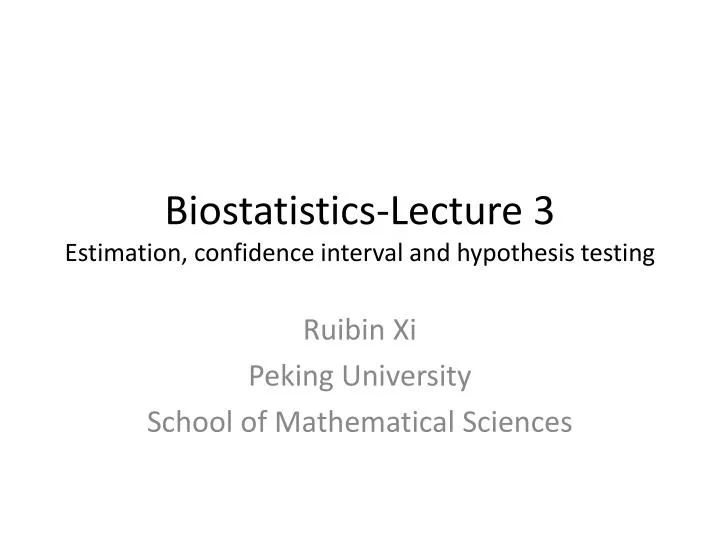

Biostatistics-Lecture 3 Estimation , confidence interval and hypothesis testing
Aug 11, 2014
400 likes | 571 Views
Biostatistics-Lecture 3 Estimation , confidence interval and hypothesis testing. Ruibin Xi Peking University School of Mathematical Sciences. Some Results in Probability (1). Suppose that X, Y are independent ( ) E( cX ) = ? (c is a constant) E(X+Y) = ? Var ( cX ) = ?
Share Presentation
- classic hypothesis testing framework
- which error
- alternative parameter values
- critical value

Presentation Transcript
Biostatistics-Lecture 3Estimation, confidence interval and hypothesis testing Ruibin Xi Peking University School of Mathematical Sciences
Some Results in Probability (1) • Suppose that X, Y are independent ( ) • E(cX) = ? (c is a constant) • E(X+Y) = ? • Var(cX) = ? • Var(X+Y) = ? • Suppose are mutually independent identically distributed (i.i.d.)
Some Results in Probability (2) • The Law of Large Number (LLN) • Assume BMI follows a normal distribution with mean 32.3 and sd 6.13
Some Results in Probability (3) • The Central Limit Theorem (CLT)
Statistical Inference • Draw conclusions about a population from a sample • Two approaches • Estimation • Hypothesis testing
Estimation • Point estimation—summary statistics from sample to give an estimate of the true population parameter • The LLN implies that when n is large, these should be close to the true parameter values • These estimates are random • Confidence intervals (CI): indicate the variability of point estimates from sample to sample
Confidence interval • Assume , then (σ is known) • Confidence interval of level 95% • Repeatedly construct the confidence interval, 95% of the time, they will cover μ • In the BMI example, μ=32.3, σ=6.13, n = 20
Confidence interval • Assume , then (σ is known) • Confidence interval • Repeatedly construct the confidence interval, 95% of the time, they will cover μ • In the BMI example, μ=32.3, σ=6.13, n = 20
Confidence Interval for the Mean • Assume , then (σ is known) • Confidence interval of level 1-α
Confidence Interval for the Mean • Assume , then (σ is known) • Confidence interval of level 1-α 1-α/2
Confidence Interval for the Mean • Assume , then (σ is known) • Confidence interval of level 1-α • What if σ is unknown? • t-statistics!
Confidence Interval for the Mean • Assume , then • by the LLN. • Replace σ2 by , then • Confidence interval of level 1-α Standard error (SE)
Confidence Interval for the Mean • Assume , then • by the LLN. • Replace σ2 by , then • Confidence interval of level 1-α
Confidence Interval for the Mean • Measure serum cholesterol (血清胆固醇) in 100 adults • Construct a 95% CI for the mean serum cholesterol based on t-distribution • CI based on normal distribution
Confidence interval based on the CLT • Assume are i.i.d. random variable with population mean μ and population variance σ2 • Construct CI for μ? • From the CLT, approximately, • From the LLN, • The asymptotic CI of level 1-α is
Confidence Interval for the proportions • Telomerase • a ribonucleoproteinpolymerase • maintains telomere ends by addition of the telomere repeat TTAGGG • usually suppressed in postnatal somatic cells • Cancer cells (~90%) often have increased telomerase activity, making them immortal (e.g. HeLa cells) • A subunit of telomerase is encode by the gene TERT (telomerase reverse transcriptase)
Confidence Interval for the proportions • Huang et. al (2013) found that TERT promoter mutation is highly recurrent in human melanoma • 50 of 70 has the mutation • Construct a 95% CI for the proportion (p) of melanoma genomes that has the TERT promoter mutation • From the data above, our estimate is • The standard error is • The CI is • Note: to guarantee this approximation good, need p and 1-p ≥ 5/n
Hypothesis testing • Scientific research often start with a hypothesis • Aspirin can prevent heart attack • Imatinib can treat CML patient • TERT mutation can promote tumor progression • Collect data and perform statistical analysis to see if the data support the hypothesis or not
Steps in hypothesis testing • Step 1. state the hypothesis • Null hypothesis H0: no different, effect is zero or no improvement • Alternative hypothesis H1: some different, effect is nonzero Directionality—one-tailed or two-tailed μ<constant μ≠constant
Steps in hypothesis testing • Step 2. choose appropriate statistics • Test statistics depends on your hypothesis • Comparing two means z-test or t-test • Test independence of two categorical variables Fisher’s test or chi-square test
Steps in hypothesis testing • Step 3. Choose the level of significance—α • How much confidence do you want in decision to reject the null hypothesis • α is also thy type I error or false positive level • Typically 0.05 or 0.01
Steps in hypothesis testing • Step 4. Determine the critical value of the test statistics that must be obtained to reject the null hypothesis under the significance level • Example—two-tailed 0.05 significance level for z-test Rejection region
Steps in hypothesis testing • Step 5. Calculate the test statistic • Example: t-statistic • Step 6. Compare the test statistic to the critical value • If the test statistic is more extreme than the critical value, reject H0 DO NOT ACCEPT H1 • Otherwise, Do Not reject or Fail to reject H0 DO NOT ACCEPT H0
Steps in hypothesis testing: an example • Data Pima.tr in the MASS package • Data from Pima Indian heritage women living in USA (≥21) testing for diabetes • Question: Is the mean BMI of Pima Indian heritage women living in USA testing for diabetes is the same as the mean women BMI (26.5) • Step 1. state the hypothesis • Let μ be the mean BMI of Pima Indian heritage women living in USA • H0: μ=26.5; H1: μ≠26.5
Steps in hypothesis testing: an example • Step 2. Choose appropriate test • Two-sided t-test • Hypotheses problem μ=μ0; H1: μ≠ μ0 • Assumptions are independent, σ is unknown • Test statistic (under H0, follows tn-1) • Critical value • Check if the test is appropriate
Steps in hypothesis testing: an example • Step 3. Choose a significance level α=0.05 • Step 4. Determine the critical value • From n = 200, • Get • Step 5. Calculate the test statistic • Step 6. Compare the test statistic to the critical value • Since|t| > Ccri,0.05,we reject the null hypothesis
P-value • Often desired to see how extreme your observed data is if the null is true • P-value • P-value • the probability that you will observe more extreme data under the null • The smallest significance level that your null would be rejected • In the previous example, P-value = P(|T|>t) = 1.3e-29
Making errors • Type I error (false positive) • Reject the null hypothesis when the null hypothesis is true • The probability of Type I error is controlled by the significance level α • Type II error (false negative) • Fail to reject the null hypothesis when the null hypothesis is false • Power = 1- probability of Type II error = 1- β • Power = P(reject H0 | H0 is false) • Which error is more serious? • Depends on the context • In the classic hypothesis testing framework, Type I error is more serious
Making Errors • Here’s an illustration of the four situations in a hypothesis test: α Power = 1-β 1-α β
Making Errors (cont.) • When H0 is false and we fail to reject it, we have made a Type II error. • We assign the letter to the probability of this mistake. • It’s harder to assess the value of because we don’t know what the value of the parameter really is. • There is no single value for --we can think of a whole collection of ’s, one for each incorrect parameter value.
Making Errors (cont.) • We could reduce for all alternative parameter values by increasing . • This would reduce but increase the chance of a Type I error. • This tension between Type I and Type II errors is inevitable. • The only way to reduce both types of errors is to collect more data. Otherwise, we just wind up trading off one kind of error against the other.
Power • When H0 is false and we reject it, we have done the right thing. • A test’s ability to detect a false hypothesis is called the power of the test. • The power of a test is the probability that it correctly rejects a false null hypothesis. • When the power is high, we can be confident that we’ve looked hard enough at the situation. • The power of a test is 1 – .
Original comparison With a larger sample size: Reducing Both Type I and Type II Error
Hypothesis test for single proportion • Kantarjian et al. (2012) studied the effect of imatinib therapy on CML patients • CML: Chronic myelogenousleukemia (慢性粒细胞性白血病) • 95% of patients have ABL-BCR gene fusion • Imatinib was introduced to target the gene fusion • Since 2001, the 8-year survival rate of CML patient in chronic phase is 87%(361/415) (with Imatinib treatment) • Before 1990, 20% • 1991-2000, 45%
Hypothesis test for single proportion • Suppose that we want to test if Imatinib can improve the 8-year survival rate • Step 1. state the hypothesis • H0: μ=0.45 vs H1: μ >0.45 (μ is the 8-year survival rate with Imatinib treatment) • Step 2. Choose appropriate test • Z-test based on the CLT • Test statistic • Follow standard normal under the null • Reject null if z > Ccrt
Hypothesis test for single proportion • Step 3. Choose the significance level α=0.01 • Step 4. Determine the critical value • Step 5. Calculate the test statistic • Step6. Compare the test statistic with the critical value, reject the null • Pvalue = 1.4e-66
- More by User
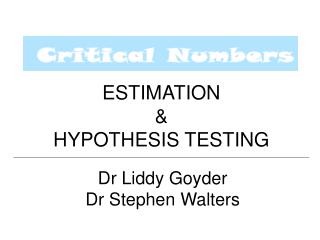
ESTIMATION & HYPOTHESIS TESTING
ESTIMATION & HYPOTHESIS TESTING. Dr Liddy Goyder Dr Stephen Walters. At the end of session, you should know about: The process of setting and testing statistical hypotheses At the end of session, you should be able to: Explain: Null hypothesis P-value, and what different values mean
3.12k views • 47 slides
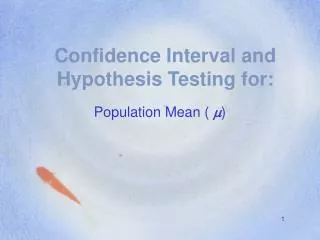
Confidence Interval and Hypothesis Testing for:
Confidence Interval and Hypothesis Testing for:. Population Mean ( ). Assumptions & Conditions. Random sample Independent observations Nearly normal distribution y ~ N ( , / n ) . Student ’ s t-Model for decisions about the mean, . -. y - . t =. s. n. With df=n-1.
635 views • 27 slides
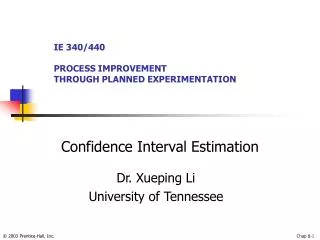
Confidence Interval Estimation
IE 340/ 440 PROCESS IMPROVEMENT THROUGH PLANNED EXPERIMENTATION. Confidence Interval Estimation. Dr. Xueping Li University of Tennessee. Chapter Topics. Estimation Process Point Estimates Interval Estimates Confidence Interval Estimation for the Mean ( Known)
908 views • 39 slides
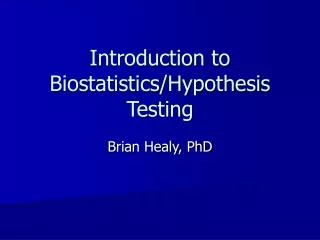
Introduction to Biostatistics/Hypothesis Testing
Introduction to Biostatistics/Hypothesis Testing. Brian Healy, PhD. Course objectives. Introduction to concepts of biostatistics Type of data Hypothesis testing p-value Choosing the best statistical test Study design When you should get help Statistical thinking, not math proofs.
1.53k views • 56 slides

Lecture 2.4 Preview: Interval Estimates and Hypothesis Testing
Lecture 2.4 Preview: Interval Estimates and Hypothesis Testing. Clint’s Assignment: Taking Stock. Estimate Reliability: Interval Estimate Question. Normal Distribution versus the Student t -Distribution: One Last Complication.
250 views • 15 slides
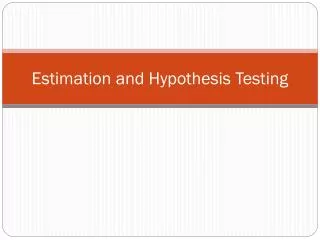
Estimation and Hypothesis Testing
Estimation and Hypothesis Testing. The Investment Decision. What would you like to know? What will be the return on my investment? Not possible PDF for return. Assume the normal PDF Use statistics to estimate E[r] and s . Use statistics to estimate the correct PDF.
485 views • 31 slides
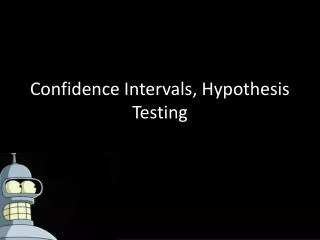

Confidence Intervals, Hypothesis Testing
Confidence Intervals, Hypothesis Testing. Example 1.
671 views • 54 slides
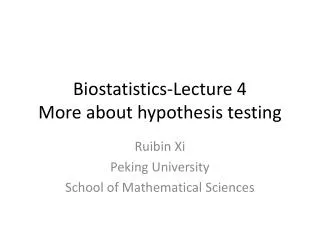
Biostatistics-Lecture 4 More about hypothesis testing
Biostatistics-Lecture 4 More about hypothesis testing. Ruibin Xi Peking University School of Mathematical Sciences. Comparing two populations—two sample z-test. Consider Fisher’s Iris data Interested to see if Sepal.Length of Setosa and versicolor are the same
283 views • 16 slides

Confidence Intervals and Hypothesis Testing
Confidence Intervals and Hypothesis Testing. Making Inferences. In this unit we will use what we know about the normal distribution, along with some new information, to make inferences about populations. Before we can do that, we need to understand more about sampling.
723 views • 52 slides

Ch. 8: Confidence Interval Estimation
Ch. 8: Confidence Interval Estimation. In chapter 6, we had information about the population and, using the theory of Sampling Distribution (chapter 7), we learned about the properties of samples. (what are they?)
438 views • 14 slides

Confidence Interval
But how close is it?. Confidence Interval. , are some parameters of the population. Suppose we want to know (say),. In general, , are not known. we take samples and we will know. s. So, what can we say about ?. and. Better. Can we say. is ?. NO!. Can we say.
796 views • 32 slides

Confidence Interval Estimation. Lesson Objective. Learn how to construct a confidence interval estimate for many situations. L.O.P. Understand the meaning of being “95%” confident by using a simulation.
598 views • 35 slides
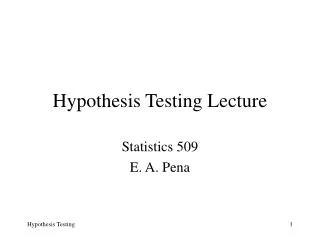
Hypothesis Testing Lecture
Hypothesis Testing Lecture. Statistics 509 E. A. Pena. Overview of this Lecture. The problem of hypotheses testing
440 views • 29 slides

Confidence Interval Estimation. For statistical inference in decision making: Chapter 6. Objectives. Central Limit Theorem Confidence Interval Estimation of the Mean ( σ known) Interpretation of the Confidence Interval Confidence Interval Estimation of the Mean ( σ unknown)
1.01k views • 70 slides
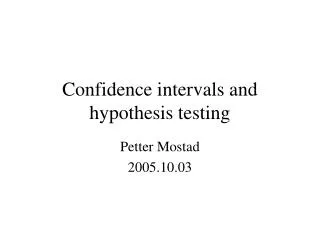
Confidence intervals and hypothesis testing
Confidence intervals and hypothesis testing. Petter Mostad 2005.10.03. Confidence intervals (repetition). Assume μ and σ 2 are some real numbers, and assume the data X 1 ,X 2 ,…,X n are a random sample from N( μ , σ 2 ). Then thus so
462 views • 29 slides
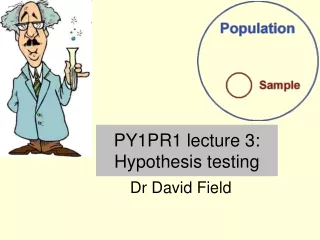
PY1PR1 lecture 3: Hypothesis testing
PY1PR1 lecture 3: Hypothesis testing. Dr David Field. Summary. Null hypothesis and alternative hypothesis Statistical significance (p-value, alpha level) One tailed and two tailed predictions What is a true experiment? random allocation to conditions Outcomes of experiments
417 views • 40 slides

Confidence Interval Estimation. For statistical inference in decision making:. Objectives. Central Limit Theorem Confidence Interval Estimation of the Mean ( σ known) Interpretation of the Confidence Interval Confidence Interval Estimation of the Mean ( σ unknown)
774 views • 70 slides
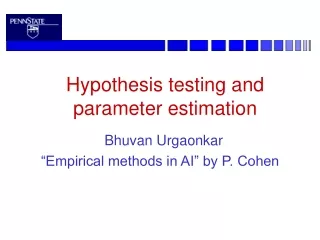
Hypothesis testing and parameter estimation
Hypothesis testing and parameter estimation. Bhuvan Urgaonkar “Empirical methods in AI” by P. Cohen. System behavior in unknown situations. Self-tuning systems ought to behave properly in situations not previously encountered
191 views • 16 slides

754 views • 70 slides

492 views • 47 slides

IMAGES